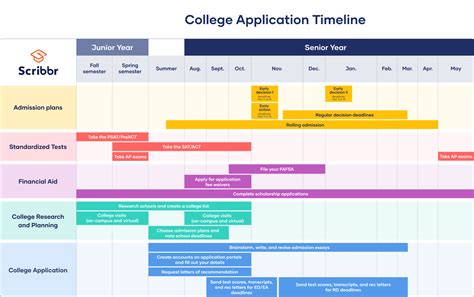As a junior in high school, the college application process may seem daunting, but it doesn’t have to be. By following a strategic timeline and staying organized, you can navigate the process efficiently and effectively. Here’s a detailed timeline to guide you:

Fall Semester: Laying the Groundwork
September-October:
- Attend college fairs: Explore different colleges and universities, gather information, and network with admissions representatives.
- Research and identify potential schools: Consider your academic interests, career goals, campus culture, and location preferences.
- Start building your college list: Narrow down your options to a manageable number of schools (10-15) that align with your aspirations.
- Take the PSAT/NMSQT (optional): This practice test can provide valuable feedback on your strengths and weaknesses and potentially qualify you for scholarships.
November-December:
- Finalize your college list: Conduct thorough research on each school and ensure it meets your needs and interests.
- Attend virtual college tours and webinars: Get a better sense of campus life and connect with admissions officers without leaving your home.
- Start drafting your personal statement: Begin brainstorming ideas and writing a rough draft.
- Request letters of recommendation: Identify teachers, counselors, or mentors who can provide insightful recommendations.
Spring Semester: Building Momentum
January-February:
- Maintain strong academic performance: Continue earning high grades in your courses, particularly in core subjects.
- Participate in extracurricular activities: Engage in activities that showcase your leadership, teamwork, and commitment.
- Refine your personal statement: Seek feedback from trusted sources and make necessary revisions.
- Finalize your list of recommenders: Ensure you have secured letters of recommendation from individuals who can attest to your character and abilities.
March-April:
- Register for the SAT or ACT (if necessary): Determine which test is right for you and schedule your test dates.
- Prepare for standardized tests: Utilize study materials, practice tests, and consider seeking professional tutoring if needed.
- Finalize your college applications: Complete all sections of the Common Application or Coalition Application and submit your transcripts and standardized test scores.
- Apply for scholarships: Research and apply for scholarships that align with your academic achievements, extracurricular involvement, or unique talents.
Summer: Tying Up Loose Ends
May-June:
- Complete any outstanding applications: Submit any remaining applications or supplemental materials.
- Follow up with colleges: Contact admissions officers if you have any questions or need additional information.
- Finalize your financial aid application (FAFSA): Complete the Free Application for Federal Student Aid (FAFSA) to determine your eligibility for financial assistance.
- Visit potential colleges (if possible): Schedule campus visits to get a firsthand experience of the schools you are considering.
Common Mistakes to Avoid
- Procrastination: Starting the application process early allows ample time for revisions, research, and seeking support.
- Lack of research: Thoroughly exploring colleges and narrowing down your options to those that fit your needs is crucial.
- Weak personal statement: The personal statement is a critical component; ensure it’s well-written, concise, and highlights your unique qualities.
- Insufficient extracurricular involvement: Extracurricular activities showcase your interests, skills, and commitment to your community.
- Overlooking financial aid: Research and apply for scholarships and grants to offset college expenses.
Step-by-Step Approach
Fall Semester:
- Attend college fairs and start identifying potential schools.
- Take the PSAT/NMSQT (optional).
- Draft a rough personal statement.
Spring Semester:
- Finalize your college list.
- Register for the SAT or ACT (if necessary).
- Refine your personal statement.
- Secure letters of recommendation.
Summer:
- Complete all college applications.
- Submit financial aid applications (FAFSA).
- Visit potential colleges (if possible).
Additional Tips for Students
- Stay organized: Keep track of deadlines, application requirements, and other important information.
- Seek support: Reach out to teachers, counselors, family members, or friends for guidance and encouragement.
- Don’t be afraid to ask for help: Don’t hesitate to contact admissions offices or writing centers for assistance with applications or essays.
- Proofread carefully: Review your applications thoroughly for any errors or inconsistencies before submitting them.
- Take breaks: Avoid burnout by scheduling regular breaks and engaging in activities that help you relax and recharge.
Conclusion
Navigating the college application process as a junior requires careful planning and execution. By following the timeline and embracing the tips provided in this article, you can build a strong foundation for success. Remember to stay organized, seek support, and showcase your strengths throughout the application process. Good luck and seize this opportunity to pursue your higher education aspirations!
Tables
Table 1: Key Deadlines for College Applications
| Deadline | Task |
|---|---|
| September-October | Attend college fairs |
| November-December | Finalize college list |
| January-February | Register for SAT/ACT |
| March-April | Complete Common Application |
| May-June | Submit FAFSA |
Table 2: Recommended Extracurricular Activities
| Activity Type | Examples |
|---|---|
| Leadership | Student government, club presidencies |
| Community Service | Volunteering, fundraising |
| Arts and Music | Band, choir, theater |
| Sports | Varsity teams, individual sports |
| Academic Clubs | Science Olympiad, debate team |
Table 3: Estimated College Application Costs
| Item | Cost |
|---|---|
| Application fees | $50-$100 per school |
| College entrance exams (SAT/ACT) | $50-$100 per exam |
| Letters of recommendation | Free (but may require a fee for submission) |
| Transcripts | Free (but may require a fee for official copies) |
| Campus visits | Free or low-cost (if self-funded) |
Table 4: Sources of Financial Aid
| Type of Aid | Eligibility Criteria |
|---|---|
| Grants | Need-based, non-repayable |
| Scholarships | Merit-based or need-based, may require specific qualifications |
| Loans | Repayable funds with interest |
| Work-study | Part-time employment on or off campus |
| 529 Plans | Tax-advantaged savings plans for education expenses |
